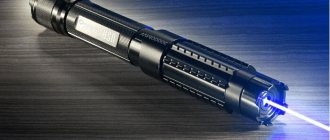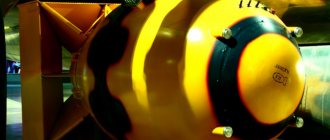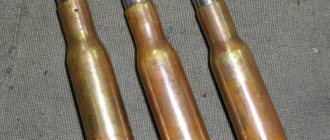Illuminated pointers are used for training, industry and as entertainment. Pointers can be battery cells or devices with solid-state lasers inside. Depending on the color, the cost and power of laser pointers vary.
Laser pointers in various colors
| Meaning | Parameter |
| Start of industrial production | 2005 year |
| Power range | 1-100 mW |
| Efficiency range | 1-25% |
| Range | From 1 to 190 kilometers |
| Power type | Batteries, solid state diodes |
Red light pointer
Red laser pointers are the cheapest to produce, since the color spectrum does not require energy consumption and have the following characteristics:
- battery - regular batteries;
- the power of such a beam ranges from 1 to 100 mW;
- The service life of such products does not exceed 1-2 years.
See also the article What is the CPSU and its history
Over time, the wavelength of the red laser shortens, the beams lose power due to a decrease in the safety margin of the battery cells or due to diode burnout.
Red lasers
Who invented the laser?
The first discoveries that gave humanity a laser were made at the dawn of the 20th century.
Einstein
Back in 1917, Albert Einstein wrote a revolutionary paper in which he laid the foundations for the quantum mechanical principle of laser operation. The revolutionary nature lay in the fact that the author predicted a completely new phenomenon in physics - stimulated emission. From Einstein's theory it follows that light can be emitted and absorbed not only spontaneously. There is also the possibility of forced (or stimulated) emission. This means that it is possible to “force” electrons to emit light of the required wavelength at the same time.
Maiman
It was possible to implement this idea in practice only in the 60s of the twentieth century. The very first laser was created by Californian physicist Theodore Maiman on May 16, 1960. This laser used a ruby crystal and a Fabry-Perot resonator. The flash lamp was the pump source. The laser operation was pulsed, the wavelength was 694.3 nm.
Basov, Prokhorov and Townes
In 1952, academicians from the USSR Nikolai Basov and Alexander Prokhorov told the whole world that it was possible to create a microwave laser powered by ammonia. The same idea was developed in parallel and independently by the American physicist Charles Townes. He created and showed how such a laser works in 1954. A decade later, in 1964, all three were awarded the Nobel Prize in Physics for these achievements.
Our days
Today we can observe very intensive development of lasers. New types of lasers are invented almost every year—chemical, excimer, semiconductor, and free electron lasers.
Green laser pointers
Devices equipped with green color are more perceived by the human eye compared to all others, however, this rule applies only during daylight hours; at night, green color is perceived worse.
The green beam laser has the following features:
- the basis for use is solid-state lasers equipped with diodes;
- efficiency factor - 20% of rated power;
- power supply - button battery;
- production began in 2006 along with other color elements;
- Green laser wavelength is 532 nm.
Green light pointer
See also the article What is a stun gun and how to choose a stun gun
Applications of lasers
The properties of laser radiation are unique. This has turned lasers into an indispensable tool for a wide variety of fields of science and technology. In addition, lasers are widely used in medicine, everyday life, the entertainment industry, and transport.
Technological lasers
- Due to their enormous power, continuous wave lasers are widely used to cut, weld or solder parts made from a wide variety of materials. At the high temperature of laser radiation, it becomes possible to weld even those materials that cannot be joined together by other methods. For example, welding metal and ceramics to obtain a new material - metal ceramics, which has unique properties.
- In order to manufacture microcircuits, a laser beam is used, which is capable of focusing into one tiny point with a diameter of the order of a micron.
- Another remarkable property of the laser beam is its perfect straightness. This allows it to be used as the most accurate “ruler” in construction. Also in construction and geodesy, pulsed lasers are used to measure vast distances on the ground, noting the time during which a light pulse moves from one point to another.
Laser communication
The emerging lasers brought communication and information recording technology to a fundamentally new level.
Radio communications, as they developed, gradually moved to shorter and shorter wavelengths, since it was proven that high frequencies (with the shortest wavelength) provide the greatest throughput to the communication channel. A real breakthrough was the understanding that light is the same electromagnetic wave, just many tens of thousands of times shorter. Consequently, it is possible to transmit through a laser beam a volume of information tens of thousands of times greater than the volume transmitted by high-frequency radio channels. As a result, various types of communication around the world have been improved.
Also, using a laser beam, CDs with sounds - music, and images - photos and films are recorded and played back. The recording industry has taken a giant step forward with this instrument.
Application of lasers in medicine
Laser technologies are widely used both in surgery and for therapeutic purposes.
- For example, thanks to its unique capabilities, a laser beam can be easily introduced through the eye pupil and “weld” the detached retina, and correct existing defects in a hard-to-reach area of the fundus of the eye.
- In modern surgery, complex operations use a laser scalpel, which minimizes damage to living tissue.
- Low power laser radiation accelerates the regeneration of damaged tissue. It also has effects similar in properties to acupuncture practiced in Eastern medicine - laser acupuncture.
- Diode and picosecond lasers are actively used in cosmetology.
Blue laser pointer
Blue laser pointers have a similar control and operation principle to green ones. Such pointers have the following characteristics:
- beam length - varies depending on the shade and for bright blue it is 445 nm, for dim (turquoise) 473 nm, and for blue 490 nm;
- the probable harm to human health is the greatest among all the colors used in pointers;
- efficiency factor - 3%, which is one of the smallest indicators;
- the main element is solid-state diodes.
Blue pointer
Power, drivers, batteries and accumulators
The laser diode can only be powered directly from the battery at very low power. For diodes from 50 milliwatts, a specialized power supply is required. Its main function is voltage stabilization. Even a 0.1 volt change can dramatically reduce the life of a laser diode.
The type of power supply determines the power of the laser pointer. It is always done with a reserve of power. By the way, the power supply is one of the simplest and cheapest elements of the pointer. A typical option is a simple power driver on a round board across the body. Power supplies for LED flashlights or, conversely, boost converters, for example, for compact fluorescent lamps, are made in the same way. The batteries used are 18650, 16340, 32650. The batteries are regular AA, AAA, C and D. Hour batteries are often found in keychain pointers.
LU yellow color
Yellow light indicators are less common among others and have the following characteristics:
- beam length - 594 nm (one of the largest indicators);
- efficiency - less than 1% - the lowest in the class;
- service life - 2-4 years;
- operating principle: solid-state diodes;
- development - 2008.
Yellow pointer
LU purple color
See also the article Swiss knives and how to choose them
A special type of light pointer associated with the emergence of a new technology for digitizing Blu-ray media. Such pointers have the following functions:
- light beam length - 405 nm;
- commissioning date - 2008;
- service life - 3-5 years;
- Operating principle: high power solid state diodes.
Purple pointer
conclusions
We are not exaggerating at all when we say that, having appeared in the middle of the 20th century, lasers played the same significant role in our lives as electricity and radio. The laser has penetrated almost all areas of human activity, and if it were suddenly removed, the world would cease to be so familiar and comfortable. Even the text of this article, which you read today from a computer or smartphone, is accessible thanks to semiconductor lasers, which are actively used in the latest optical communications. Without lasers it is impossible to imagine computers, and therefore a huge layer of modern human life. Being very interestingly designed, the laser opens up new development prospects for modern science. Its properties are incredibly multifaceted, and we can safely say that the laser beam “lights” its path in absolutely all areas of human life, making it better and happier!
Applications of laser pointers
The use of laser pointers has a wide range and extends to many areas of life. Most often they are used:
- for highlighting targets in collimator sights of firearms (pistols, rifles, machine guns), as well as target designators for artillery or aviation operation at short distances;
- in scientific activities, such pointers are used to detect gas in liquids when it is impossible to recognize it with the ordinary human eye;
- Chinese green laser is used in astronomical research. Such pointers are used to explore the boundaries visible to the eye and designate space objects and fix them. At night, scientists use pointers of various spectra to determine the direction of stars, fixing it with a directed beam of light;
- in educational activities, such pointers are used to demonstrate presentations, lectures and scientific seminars that require demonstration using a color pointer;
- in political and social activities, pointers are used for presentations, to explain patterns of social processes and to concentrate the attention of the hall, public, and meeting.
See also the article Collimator sights and operating principles
Pointers in three popular colors
Laser device
Three components—the working fluid (working medium), the pump mechanism, and the optical cavity—are common to each laser. They determine the type of laser and what you can achieve with it. Below we will talk about all three components in more detail.
Rice. 2. Laser device: optical cavity with working medium and ray path
Working fluid (working environment)
You generate photons in the working environment of the laser. This emission occurs through optical transitions in excited atoms or molecules. As a result of these transitions, particles move into energetically more favorable states. The most important condition of the laser medium is the possibility of creating the effect of inversion of electronic populations.
To do this, it must have at least three energy levels. Energy levels are the energy eigenvalues of quantum mechanical systems. An atom or molecule can only be at one of these levels. The lowest level is the ground state, and all the others are excited states.
Inversion of electronic populations means that the upper state of the optical transition is more likely to be occupied than the lower one. Such media can be gaseous, liquid or solid.
Pumping mechanism
Optical pumping is the process by which you add energy to a medium. This is done by exciting the working environment using an external energy source, such as other lasers or a flash lamp. In this way, electron population inversion is achieved without the pumping process competing with stimulated emission. Therefore, a different quantum mechanical junction is pumped than the one that is ultimately used to emit photons.
Optical resonator
Using an optical cavity, you determine the speed of radiation and the properties of photons. With reflection, you allow individual photons to pass through a medium multiple times. This induces further emission in the desired direction and allows the light to be amplified.
To do this, photons must propagate perpendicular to the reflecting medium. Photons emitted in this way have the same quantum numbers as the photons fired. Any spontaneous emissions that may occur will not themselves generate any further photons, as they are very unlikely to be emitted perpendicular to the reflective medium.
Thanks to this choice, a very narrow direction of the laser beam is achieved.
Laser Safety
The safety of using lasers is an integral part of their daily use; such devices are not harmless and may pose a certain danger, depending on how the laser pointer is designed. The danger of the green ray is the highest.
Negative consequences when using the most powerful laser pointer without observing safety precautions can be as follows:
- If it comes into contact with the eyes, even for a short time, laser light can cause a burn to the retina of the eye, which will lead to impaired vision or partial loss of it. Such a hit can lead to fatal consequences if such a beam is used on pilots or car drivers (in 2013 in Russia, civil aviation pilots were blinded on approach to cities, which could lead to plane crashes);
- damage to the skin - when using powerful lasers with a strong light beam for several minutes, a 2-3 degree burn may remain on an open area of skin.
These consequences have led to a legal ban on the possession of laser pointers in some countries, and they also lead to precautions when using such devices:
- do not shine into the eyes - when using a pointer, it is prohibited to direct the light beam into a person’s eyes, even for a short period of time, in order to avoid burns to the retina;
- do not point at open areas of the body - when using powerful lasers, this can also cause burns to the surface of the body;
- do not irradiate vehicle drivers - this can lead to transport accidents and property damage, even death.
Photo of a laser pointer
Laser functions
You excite the atoms or molecules of the laser medium to higher energy levels. This way you create a laser beam. These energy levels have the maximum possible average decay time. This way you keep the probability of spontaneous emission as low as possible and the energy of the pumping process is retained longer. Continuous pumping creates the desired inversion of electron populations. This means that more particles are in one of their excited states than in the ground state.
Now, in order for the excited atom to return from its excited state to the ground state, it is only necessary to stimulate it with a photon. In doing so, it emits a photon in the same direction and with the same energy as the original photon. In this case, equal energy means that the new photon has the same frequency and wavelength as the original photon. The phase position of both photons is also the same.
As described earlier, photons are reflected in the resonator and pass through the medium several times. This process leads to a chain reaction in which more and more photons are produced, which in turn produce more and more photons, and so on...
One side of the resonator is partially transparent, allowing the laser beam to be deflected. As a result, the reflective property of the resonator is preserved, and further radiation occurs.
Spontaneous emission
Spontaneous emission is a quantum mechanical phenomenon. This occurs when atoms or molecules emit photons as they move from higher energy levels to lower ones. This type of radiation is impossible to predict. This is a decay process, the occurrence of which can be estimated with a certain probability.
So, spontaneous radiation is radiation emitted during the spontaneous transition of an atom from an excited state to a ground state.
Spontaneous emission from different atoms occurs incoherently, since each atom starts and stops emitting independently of the others.
Mathematically this can be expressed as follows:
The formula states that the number N of spontaneous emissions or excited particles per volume V and time t is proportional to the density of the number of particles n in the excited state.
Stimulated emission
Laser operation is based on stimulated emission. Here the emission of a photon does not occur spontaneously.
Let us recall that when an atom transitions from a stationary state with higher energy to a state with lower energy, it emits an energy quantum (photon). Such radiation can be spontaneous. In this case, atoms emit photons of different frequencies, which is determined by transitions to different energy levels.
It is possible to make sure that an atom in an excited state emits energy under the influence of external factors, for example, under the influence of light falling on it. Such radiation is called forced (induced).
Let us assume that an atom can go from a state with energy 2 to a state with energy 1 and at the same time emit a photon with energy hv = E2 - E1. If it interacts with a photon of the same frequency, then the probability of stimulated emission is quite high and the result is two photons of the same frequency. Thus, the light wave emitted is no different from the one that falls on the atom. It has the same frequency and phase.
[2]
To create stimulated emission, it is necessary to increase the number of atoms with a high energy level. This can be accomplished using substances whose atoms can remain in an excited state for a long enough time without spontaneously emitting.
Longitudinal modes
Depending on the design of the resonator, a different number of standing waves of a certain length can be formed in it. Thus, certain wavelengths and their multiples can be particularly amplified by such a resonator. These different modes of vibration are called modes. Given the number of longitudinal modes, you know how many waves can oscillate in the resonator. Oscillations along the direction of propagation of radiation are called longitudinal. These are peaks and valleys of intensity at half-wavelength intervals.
Lasers are divided into single-mode lasers, which oscillate at almost the same frequency, and multimode lasers.
Transverse modes
Transverse mode refers to the wave phase distribution perpendicular to the direction of propagation. Consequently, a mode that is not perpendicular to the cavity mirrors results in a laser frequency shift. The reason for this is the increase in the length of the resonator, which now leads to the formation of standing waves with nodes in the laser profile.
If you use a cylindrical resonator, your beam will ideally have a Gaussian shape. When using modes that are not perpendicular to the resonator mirrors, profiles with radial and angular dependence are formed instead. They change the length of the cavity as the path length between the mirrors changes. This can distort the spectra of longitudinal modes as different transverse modes overlap each other.
Which laser pointer is the most powerful?
The laser pointer market is becoming saturated every year with new models, the tendency of which is to increase power through the use of modern LEDs.
The leading manufacturers in this regard are the Chinese company Wicked Lasers, which produces the most powerful lasers capable of transmitting a beam over distances of tens and hundreds of kilometers. The beam range depends on what the laser pointer is made of.
Laser pointer made by Wicked Lasers
In 2022, it will be determined which laser is more powerful. A record case of transmitting a green light beam over a distance of 190 kilometers was recorded.
See also the article The role of jihad in the history of Russia and the world
Properties of laser radiation
Light from a laser has special and very valuable properties that distinguish it favorably from light from conventional thermal sources.
- Laser radiation is coherent and almost completely monochromatic. Previously, such properties were only found in radio waves from well-stabilized transmitters.
- Propagation of stimulated emission occurs only along the axis of the resonator. In this regard, the expansion of the laser beam is very weak and has an almost imperceptible divergence (several arc seconds).
- Thanks to the above properties, the laser beam is able to focus into an incredibly small point. The energy at its focal point has enormous density.
- Due to the monochromatic nature of the radiation and the extreme energy density, laser radiation can reach very high temperatures. For example, the radiation temperature of a pulsed laser with a power of the order of a petawatt (1015 W) is more than 100 million degrees.










